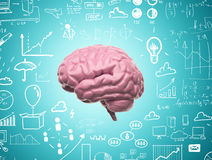
In the sense that materialists must talk nonsense to explain it away:
Our mind-body problem is not just a difficulty about how the mind and body are related and how they affect one another. It is also a difficulty about how they can be related and how they can affect one another. Their characteristic properties are very different, like oil and water, which simply won’t mix, given what they are. There is a very common view which states that the French philosopher René Descartes discovered, or invented, this problem in the 17th century…
What is characteristic of a mind, Descartes claims, is that it is conscious, not that it has shape or consists of physical matter. Unlike the brain, which has physical characteristics and occupies space, it does not seem to make sense to attach spatial descriptions to it. In short, our bodies are certainly in space, and our minds are not, in the very straightforward sense that the assignation of linear dimensions and locations to them or to their contents and activities is unintelligible. That this straightforward test of physicality has survived all the philosophical changes of opinion since Descartes, almost unscathed, is remarkable…
What happens, if anything, for example, when we decide to do even such a simple thing as to lift up a cup and take a sip of coffee? The arm moves, but it is difficult to see how the thought or desire could make that happen. It is as though a ghost were to try to lift up a coffee cup. Its ghostly arm would, one supposes, simply pass through the cup without affecting it and without being able to cause it or the physical arm to go up in the air.
Jonathan Westphal, “Descartes and the Discovery of the Mind-Body Problem” at Aeon
We all experience this. But the mind-body “problem” is the nonsense materialists are led into in order to make the obvious meaning of the experience of an immaterial mind disappear in a dense weed jungle of verbiage.
How they have tried to address the dilemma: Why some scientists believe the universe is conscious. They’re not mystics. But materialism is not giving good answers so they are looking around. These prominent thinkers are driven to panpsychism because materialism about the mind doesn’t really work. So if panpsychism ends up seeming absurd, dualism—there really is an immaterial world—is also worth considering.
Why some scientists think science is an illusion. It’s a useful illusion, they say, but our brains are not really wired to know the facts. The great triumph of the theory of evolution was to show that humans are just animals in nature—clever, yes, but clever animals. Or so we are told. But wait!
Panpsychism: You are conscious but so is your coffee mug
and
How can consciousness be a material thing? Well, as the materialist philosopher himself will explain, he must see it that way.)